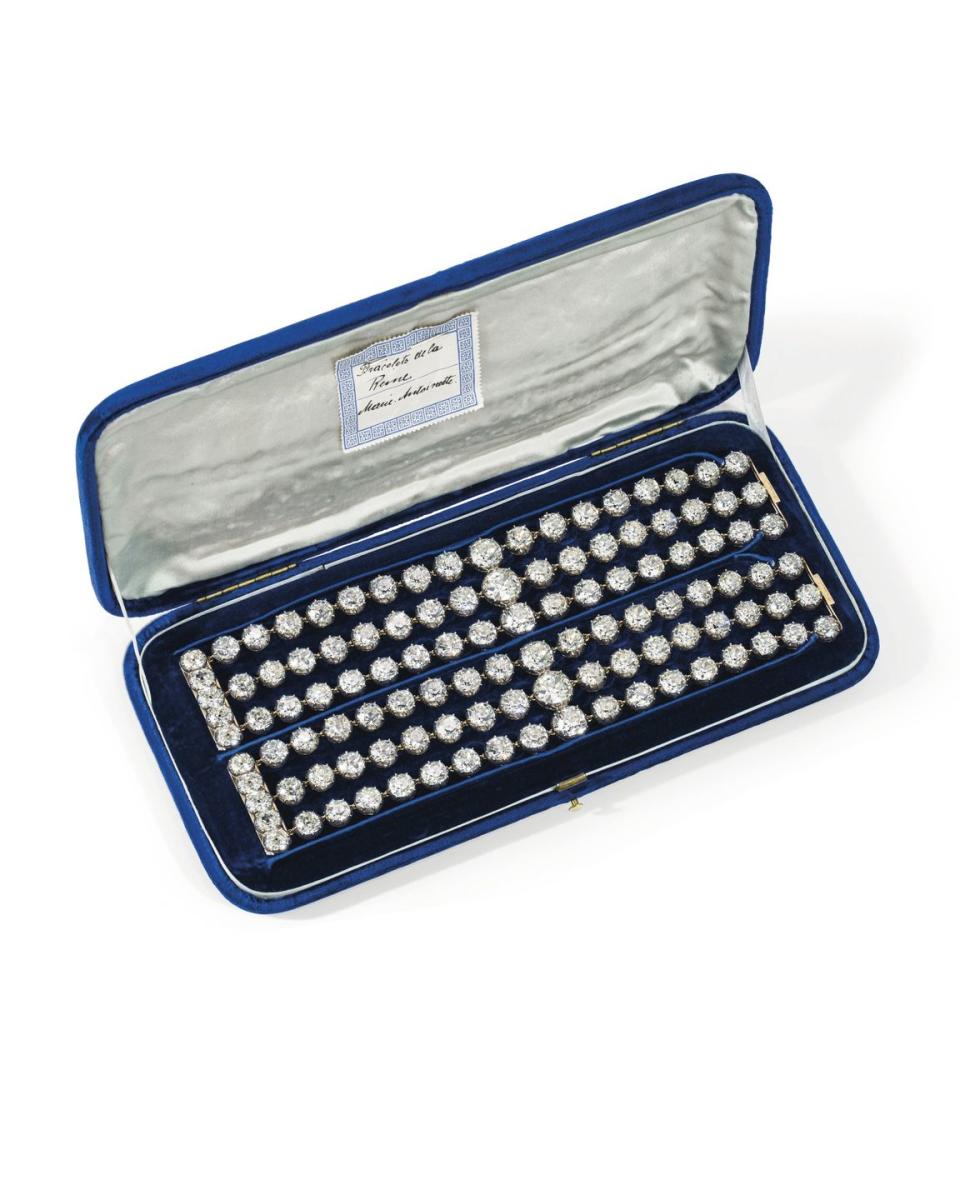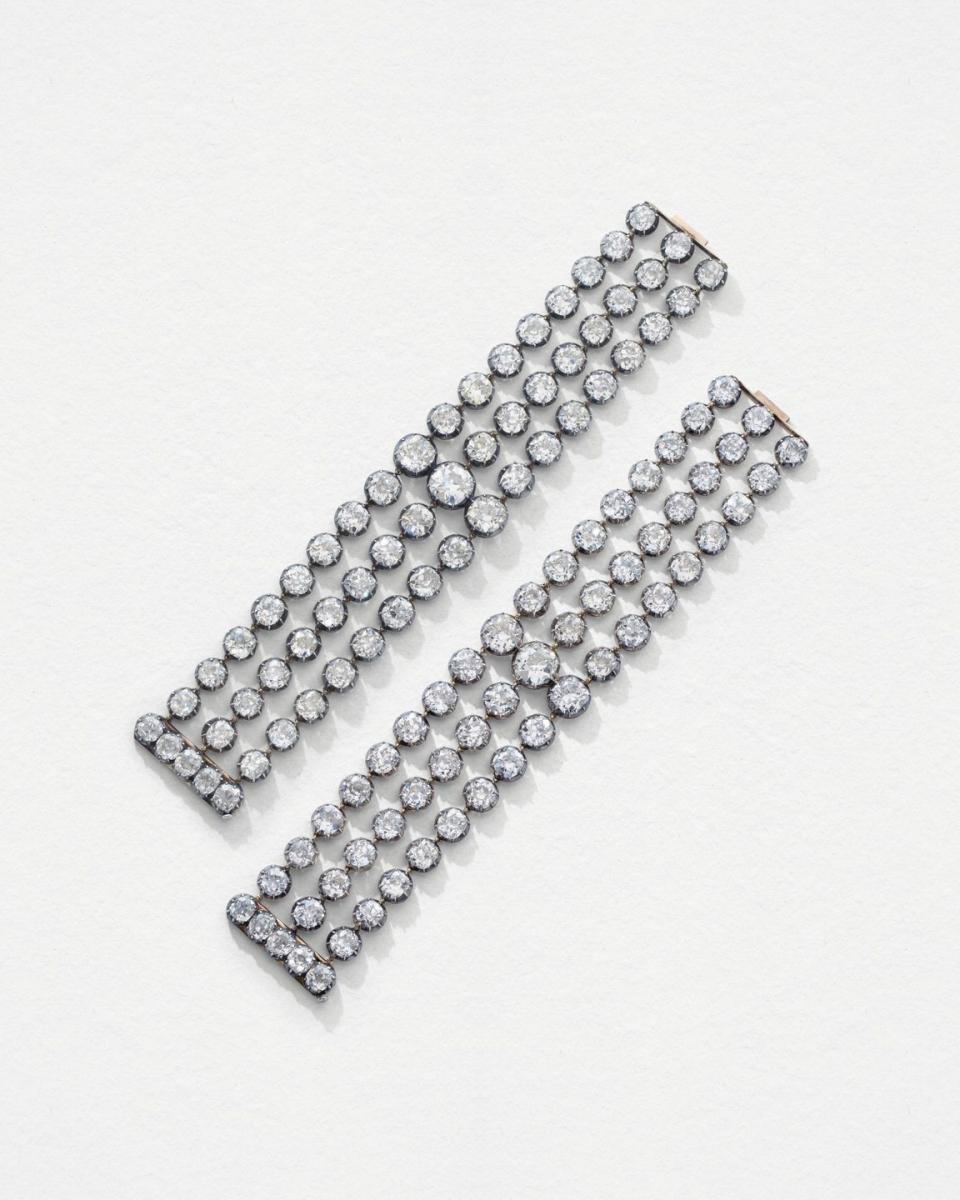Marie-Antoinette’s Secret Diamond Bracelets Hit the Auction Block

- Oops!Something went wrong.Please try again later.
During Queen Marie-Antoinette’s final years, when was she locked away in the Tuileries Palace in Paris, she secretly packed her jewels in a wooden crate and sent them to Austrian ambassador Count Mercy-Argenteau for safekeeping. Feeling so confident that she would soon be exonerated and be free to retrieve her jewelry, the doomed monarch even ordered a Breguet watch while awaiting trial. Obviously, she would never get the chance to claim neither watch nor box of jewels—Marie-Antoinette was sent to the guillotine in 1793.
More than two centuries later, a pair of diamond bracelets that had been packed away in said wooden crate have resurfaced and will be offered at the Christie’s Magnificent Jewels sale in Geneva on November 9. The chic three-strand bracelets are set with 112 diamonds and valued between $2 million to $4 million, but with a provenance this good, they will likely sell for much higher.

“They revive and transport a part of French history into today's world,” says Marie-Cécile Cisamolo, an associate specialist at Christie's Geneva. What makes these diamond jewels even more exceptional is that they weren’t transformed over time—they seem to have been left just as the Queen purchased them. “We can assume that the simple design spoke to its different owners over the past 226 years," she says.
To trace their provenance, we begin with Marie-Antoinette's famously insatiable appetite for jewelry. Not one to worry about a budget, the Queen purchased the bracelets from Boehmer for 250,000 livres. She didn’t exactly have the cash on hand to buy them, so she instead delivered a down payment and traded in some other gems. Newly uncovered information from jewelry historian Vincent Meylan reveals that King Louis XVI’s personal papers from February 1777 read: "to the Queen: down payment of 29,000 livres for the diamond bracelets she bought from Boehmer." Count Mercy-Argenteau had also reported they were partly paid for in gemstones from the Queen’s collection.
Whatever jewels that survived the French Revolution were ultimately sold off. After Napoleon III’s defeat, the new government offered up the Crown jewels in the famous sale of 1887, where treasures including grand tiaras, crowns, and other important jewelry went to the highest bidders, including Tiffany & Co. Most of those pieces were broken apart and refashioned into new designs. It’s still a sore point for the French, because it’s been said that if they had survived, the French Crown Jewels would be more far more valuable than the British Royal Jewels that are on display at the Tower of London—but we will never know.
The faithful Count Mercy-Argenteau kept the wooden crate unopened for more than a year, until the Austrian court ordered an inventory of its contents—the bracelets were listed as item number 6. In 1796, when the Queen’s surviving daughter Madame Royale (1778-1851) arrived in Austria at age 18, she was given the jewels. An 1816 portrait of Madame Royal by painter Antoine-Jean Gros shows her wearing the bracelets. She died childless in 1851 and left her jewels to be divided among her nieces and nephews: the Count of Chambord (1820-1883), the Countess of Chambord (1817-1886) and the Duchess of Parma (1819-1864).

Fast forward to the present day: the diamond bracelets come courtesy of an unnamed royal family who, according to Christie’s, enjoyed wearing them for several decades. Designed as three single strands of diamonds, you might say they are the early versions of diamond tennis bracelets, which only further affirms Marie-Antoinette's status as a trend-setter with an eye for elegantly stylish jewelry.
“Wearing these pieces is like wrapping your wrist in silk,” says Cisamolo. “They are light, flexible and honestly very easy to wear.” And for a couple million, these fascinating fragments of history could become yours.
You Might Also Like

